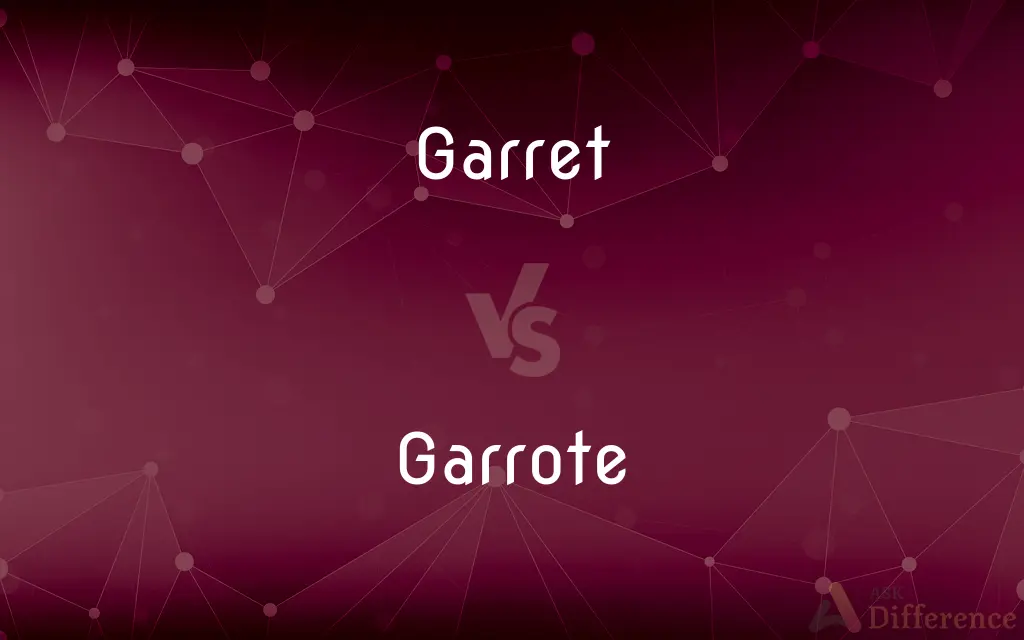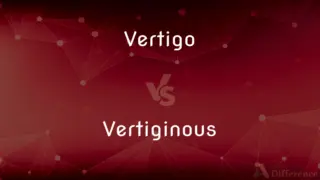Garret vs. Garrote — What's the Difference?
By Tayyaba Rehman & Fiza Rafique — Updated on April 29, 2024
Garret is an attic or top-floor room in a house, typically used as a living space or storage, while a garrote is a weapon for strangulation.

Difference Between Garret and Garrote
Table of Contents
ADVERTISEMENT
Key Differences
A garret is often found in older houses, serving as an attic or small, top-floor room, usually characterized by its sloped ceilings due to the roof's shape. On the other hand, a garrote refers to a device used to execute by strangulation, typically consisting of a length of wire, rope, or chain and handles or a mechanism to tighten the wire.
In literature and historical contexts, a garret is commonly depicted as a cramped but charming space where artists or writers find solitude and inspiration. Whereas, a garrote is associated with darker themes, often appearing in contexts related to espionage, punishment, or executions, particularly in historical European or Latin American settings.
From a real estate perspective, a garret can add character and value to a property, offering additional living space or a quaint retreat. In contrast, the mention of a garrote generally carries negative connotations, emphasizing danger and violence rather than any functional or aesthetic value.
While renovations can transform a garret into a more habitable and attractive space, enhancing its usability and appeal, a garrote is a static tool with a specific and unchanging function, highlighting stark differences in utility and perception between the two.
Comparison Chart
Usage
Residential, artistic or storage space
Execution or assassination tool
ADVERTISEMENT
Connotation
Quaint, charming, creative
Dangerous, violent
Historical Context
Common in 19th century European homes
Used in executions historically
Transformation
Can be renovated or remodeled
Has a fixed purpose and function
Compare with Definitions
Garret
Historically, a less desirable living space due to access or design.
The servants' quarters were in the narrow garret of the old mansion.
Garrote
Associated with martial arts and covert operations.
He demonstrated how to use a garrote in self-defense classes.
Garret
A symbol of artistic struggle and bohemian lifestyle.
Many romantic poets of the 18th century preferred living in garrets.
Garrote
A method of execution involving strangulation.
The spy was feared for his use of the garrote in silent killings.
Garret
A top-floor apartment, typically modest and cramped.
His first apartment was a tiny garret overlooking the city skyline.
Garrote
An implement in historical European justice systems.
The garrote was once a common execution tool in Spain.
Garret
A secluded or isolated workspace.
The author retreated to his garret every summer to write in solitude.
Garrote
A strangling device made of cord or wire.
The assassin's tool of choice was a steel garrote.
Garret
An attic room, often small and under the eaves.
She converted the garret into a bright studio for her painting.
Garrote
A method of execution formerly practiced in Spain, in which a tightened iron collar is used to strangle or break the neck of a condemned person.
Garret
A garret is a habitable attic, a living space at the top of a house or larger residential building, often small, dismal, and cramped, with sloping ceilings. In the days before elevators this was the least prestigious position in a building, at the very top of the stairs.
Garrote
The iron collar used for such an execution.
Garret
A top-floor or attic room, especially a small dismal one
The solitary genius starving in a cold garret
Garrote
Strangulation, especially in order to rob.
Garret
A room or set of rooms immediately under the roof of a building; an attic.
Garrote
A cord or wire used for strangling.
Garret
An attic or semi-finished room just beneath the roof of a house.
Garrote
To execute by garrote.
Garret
A turret; a watchtower.
He saw men go up and down on the garrets of the gates and walls.
Garrote
To strangle in order to rob.
Garret
That part of a house which is on the upper floor, immediately under or within the roof; an attic.
The tottering garrets which overhung the streets of Rome.
Garrote
An iron collar formerly used in Spain to execute people by strangulation Category:en:Capital punishment
Garret
Floor consisting of open space at the top of a house just below roof; often used for storage
Garrote
Something, especially a cord or wire, used for strangulation
The mob boss was known for having his enemies executed with a garrote of piano wire.
Garrote
(transitive) to execute by strangulation
Garrote
(transitive) to kill using a garrote
Garrote
A Spanish mode of execution by strangulation, with an iron collar affixed to a post and tightened by a screw until life become extinct.
Garrote
The instrument by means of which the garrote{1} is inflicted.
Garrote
A short length of rope or other instrument used to strangle a person.
Garrote
To strangle with the garrote; hence, to seize by the throat, from behind, with a view to strangle and rob.
Garrote
An instrument of execution for execution by strangulation
Garrote
Strangle with an iron collar;
People were garrotted during the Inquisition in Spain
Common Curiosities
How does one access a garret?
Garrets are usually accessed through a staircase or a ladder, often being located on the top floor of a building.
How is a garrote used?
A garrote is used by placing it around a person’s neck and tightening it until suffocation occurs.
What is the origin of the garrote?
The garrote likely originated as an execution tool in Europe, with historical use particularly noted in Spain.
Are garrets energy efficient?
Due to their location under the roof, garrets can have issues with heating and cooling, but proper insulation can improve their energy efficiency.
What types of buildings feature garrets most prominently?
Garrets are most prominently featured in Victorian and older European-style buildings where maximizing space under steep roofs is desirable.
What is a garret used for?
A garret is typically used as a living space or for storage in homes, especially in historical buildings.
What historical significance does a garrote have?
Historically, the garrote has been used as a method of execution, particularly in Spain and some Latin American countries, until the mid-20th century.
Why is a garret considered desirable?
Garrets are often valued for their quaint charm and the privacy they offer, making them desirable for artists and writers.
Is the use of a garrote legal?
The use of a garrote is illegal in most jurisdictions and is associated with violent crime, including murder and assassination.
Can a garret be expanded or modified?
Yes, garrets can often be remodeled or expanded, depending on building codes and structural allowances.
Can a garret be used for habitation?
Yes, a garret can be used for habitation, often being utilized as a budget-friendly living space, though it may come with challenges like low ceilings and poor insulation.
What are the cultural associations of a garrote?
Culturally, a garrote is often associated with espionage, military executions, and historical criminal activities, featured prominently in spy novels and crime stories.
Are there modern uses for garrets?
Modern uses for garrets include artist studios, small office spaces, or quirky guest rooms, capitalizing on their unique architectural features.
Share Your Discovery

Previous Comparison
Loop vs. Mesh
Next Comparison
Vertigo vs. VertiginousAuthor Spotlight
Written by
Tayyaba RehmanTayyaba Rehman is a distinguished writer, currently serving as a primary contributor to askdifference.com. As a researcher in semantics and etymology, Tayyaba's passion for the complexity of languages and their distinctions has found a perfect home on the platform. Tayyaba delves into the intricacies of language, distinguishing between commonly confused words and phrases, thereby providing clarity for readers worldwide.
Co-written by
Fiza RafiqueFiza Rafique is a skilled content writer at AskDifference.com, where she meticulously refines and enhances written pieces. Drawing from her vast editorial expertise, Fiza ensures clarity, accuracy, and precision in every article. Passionate about language, she continually seeks to elevate the quality of content for readers worldwide.
















































